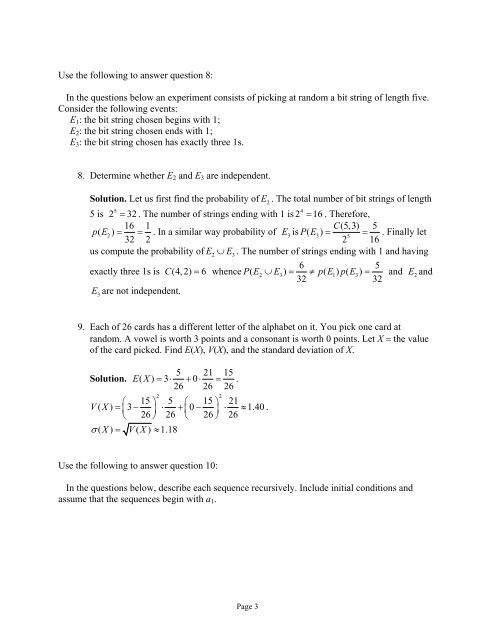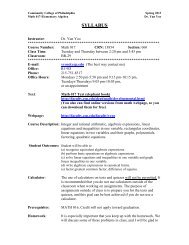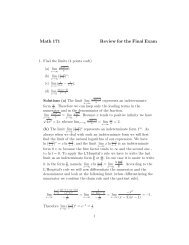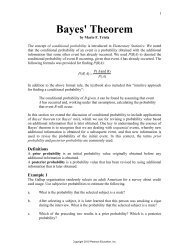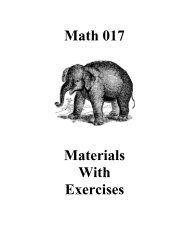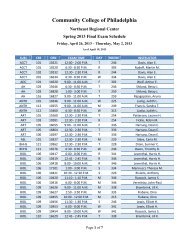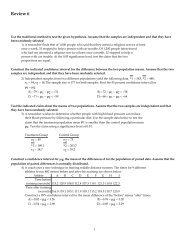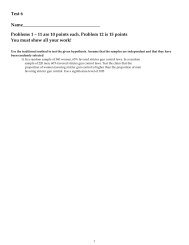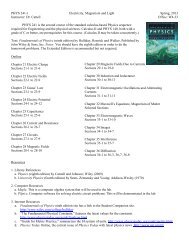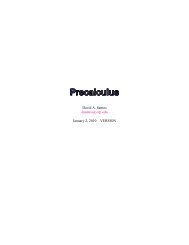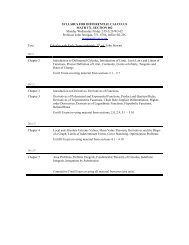163 Discrete Mathematics Review 2 Use the following to answer ...
163 Discrete Mathematics Review 2 Use the following to answer ...
163 Discrete Mathematics Review 2 Use the following to answer ...
You also want an ePaper? Increase the reach of your titles
YUMPU automatically turns print PDFs into web optimized ePapers that Google loves.
<strong>Use</strong> <strong>the</strong> <strong>following</strong> <strong>to</strong> <strong>answer</strong> question 8:<br />
In <strong>the</strong> questions below an experiment consists of picking at random a bit string of length five.<br />
Consider <strong>the</strong> <strong>following</strong> events:<br />
E 1 : <strong>the</strong> bit string chosen begins with 1;<br />
E 2 : <strong>the</strong> bit string chosen ends with 1;<br />
E 3 : <strong>the</strong> bit string chosen has exactly three 1s.<br />
8. Determine whe<strong>the</strong>r E 2 and E 3 are independent.<br />
Solution. Let us first find <strong>the</strong> probability of<br />
. The <strong>to</strong>tal number of bit strings of length<br />
5<br />
4<br />
5 is 2 = 32. The number of strings ending with 1 is 2 = 16. Therefore,<br />
16 1<br />
C(5,3) 5<br />
pE (<br />
2)<br />
= = . In a similar way probability of E3<br />
is PE (<br />
3)<br />
= = . Finally let<br />
5<br />
32 2<br />
2 16<br />
us compute <strong>the</strong> probability of E ∪ E . The number of strings ending with 1 and having<br />
2<br />
3<br />
6 5<br />
exactly three 1s is C (4,2) = 6 whence PE (<br />
2<br />
∪ E3)<br />
= ≠ pE (<br />
1) pE (<br />
3)<br />
=<br />
32 32<br />
are not independent.<br />
E 3<br />
E 2<br />
and E and 2<br />
9. Each of 26 cards has a different letter of <strong>the</strong> alphabet on it. You pick one card at<br />
random. A vowel is worth 3 points and a consonant is worth 0 points. Let X = <strong>the</strong> value<br />
of <strong>the</strong> card picked. Find E(X), V(X), and <strong>the</strong> standard deviation of X.<br />
5 21 1<br />
Solution. EX ( ) = 3⋅ + 0⋅ = 5 .<br />
26 26 26<br />
2 2<br />
⎛ 15 ⎞ 5 ⎛ 15 ⎞ 21<br />
V( X) = ⎜3− ⎟ ⋅ + ⎜0 − ⎟ ⋅ ≈1.40<br />
.<br />
⎝ 26 ⎠ 26 ⎝ 26 ⎠ 26<br />
σ ( X) = V( X) ≈ 1.18<br />
<strong>Use</strong> <strong>the</strong> <strong>following</strong> <strong>to</strong> <strong>answer</strong> question 10:<br />
In <strong>the</strong> questions below, describe each sequence recursively. Include initial conditions and<br />
assume that <strong>the</strong> sequences begin with a 1 .<br />
Page 3


